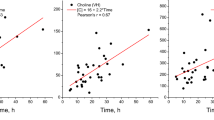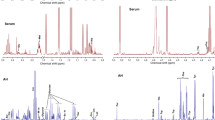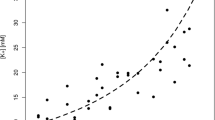Abstract
Introduction
The analysis of post-mortem metabolomic changes in biological fluids opens the way to develop new methods for the estimation of post-mortem interval (PMI). It may also help in the analysis of disease-induced metabolomic changes in human tissues when the postoperational samples are compared to the post-mortem samples from healthy donors.
Objectives
The goals of this study are to observe and classify the post-mortem changes occurring in the rabbit blood, aqueous and vitreous humors (AH and VH), to identify the potential PMI markers among a wide range of metabolites, and also to determine which biological fluid—blood, AH or VH—is more suitable for the PMI estimation.
Methods
The quantitative metabolomic profiling of samples of the rabbit serum, AH and VH taken at different PMIs has been performed with the combined use of high-frequency NMR and high-resolution LC–MS methods.
Results
The quantitative levels of 61 metabolites in the rabbit serum, AH and VH at different PMIs have been measured. It has been found that the post-mortem metabolomic changes in AH and VH proceed slower than in blood, and the data scattering is lower. Among the metabolites whose concentrations increase with time, the most significant and linear growth is found for hypoxanthine, choline and glycerol.
Conclusion
The obtained results suggest that the ocular fluids AH and VH may have some advantages over blood serum for the search of potential biochemical markers for the PMI estimation. Among the compounds studied in the present work, hypoxanthine, choline and glycerol give the biggest promise as the potential PMI biomarkers.





Similar content being viewed by others
References
Costa, I., Carvalho, F., Magalhães, T., de Pinho, P. G., Silvestre, R., & Dinis-Oliveira, R. J. (2015). Promising blood-derived biomarkers for estimation of the postmortem interval. Toxicology Research, 4(6), 1443–1452.
Cotran, R. S., Kumar, V., & Robbins, S. L. (1994). Cellular injury and cellular death (5th ed.). Philadelphia: W. B. Saunders Company.
DiMattio, J. (1989). A comparative study of ascorbic acid entry into aqueous and vitreous humors of the rat and guinea pig. Investigative Ophthalmology & Visual Science, 30(11), 2320–2331.
Donaldson, A. E., & Lamont, I. L. (2013). Biochemistry changes that occur after death: Potential markers for determining post-mortem interval. PLoS One, 8(11), e82011.
Donaldson, A. E., & Lamont, I. L. (2014). Estimation of post-mortem interval using biochemical markers. Australian Journal of Forensic Sciences, 46(1), 8–26.
Donaldson, A. E., & Lamont, I. L. (2015). Metabolomics of post-mortem blood: Identifying potential markers of post-mortem interval. Metabolomics, 11(1), 237–245.
Gowda, N. G. A., Gowda, Y. N., & Raftery, D. (2015). Expanding the limits of human blood metabolite quantitation using NMR spectroscopy. Analytical Chemistry, 87(1), 706–715.
Gurler, M., Ozturk, G., Kir, M. Z., Ginis, Z., Erden, G., Akyol, S., et al. (2016). Simultaneous analysis of biochemical markers in vitreous humour and serum: A preliminary study on the effect of storage time at −20 °C. Australian Journal of Forensic Sciences, 48(2), 150–158.
James, R. A., Hoadley, P. A., & Sampson, B. G. (1997). Determination of postmortem interval by sampling vitreous humour. The American Journal of Forensic Medicine and Pathology, 18(2), 158–162.
Janaway, R. C., Percival, S. L., & Wilson, A. S. (2009). Decomposition of human remains. In S. L. Percival (Ed.), Microbiology and aging (pp. 313–334). New York: Humana Press.
Kryczka, T., Ehlers, N., Nielsen, K., Wylegala, E., Dobrowolski, D., & Midelfart, A. (2013). Metabolic profile of keratoconic cornea. Current Eye Research, 38(2), 305–309.
Madea, B., & Rödig, A. (2006). Time of death dependent criteria in vitreous humor: Accuracy of estimating the time since death. Forensic Science International, 164(2–3), 87–92.
Palmiere, C., & Mangin, P. (2015). Urea nitrogen, creatinine, and uric acid levels in postmortem serum, vitreous humor, and pericardial fluid. International Journal of Legal Medicine, 129(2), 301–305.
Poulsen, J. P., Rognum, T. O., Oyasaeter, S., & Saugstad, O. D. (1990). Changes in oxypurine concentrations in vitreous humor of pigs during hypoxemia and post-mortem. Pediatric Research, 28(5), 482–484.
Reiss, G. R., Werness, P. G., Zollman, P. E., & Brubaker, R. F. (1986). Ascorbic acid levels in the aqueous humor of nocturnal and diurnal mammals. Archives of Ophthalmology, 104(5), 753–755.
Rognum, T. O., Hauge, S., Oyasaeter, S., & Saugstad, O. D. (1991). A new biochemical method for estimation of postmortem time. Forensic Science International, 51(1), 139–146.
Sato, T., Zaitsu, K., Tsuboi, K., Nomura, M., Kusano, M., Shima, N., et al. (2015). A preliminary study on postmortem interval estimation of suffocated rats by GC-MS/MS-based plasma metabolic profiling. Analytical and Bioanalytical Chemistry, 407(13), 3659–3665.
Saugstad, O. D. (1975). Hypoxanthine as a measurement of hypoxia. Pediatric Research, 9(4), 158–161.
Saugstad, O. D., & Olaisen, B. (1978). Post-mortem hypoxanthine levels in the vitreous humour an introductory report. Forensic Science International, 12(1), 33–36.
Sherin, P. S., Zelentsova, E. A., Sormacheva, E. D., Yanshole, V. V., Duzhak, T. G., & Tsentalovich, Y. P. (2016). Aggregation of α-crystallins in kynurenic acid-sensitized UVA photolysis under anaerobic conditions. Physical Chemistry Chemical Physics, 18(13), 8827–8839.
Snytnikova, O. A., Sherin, P. S., Kopylova, L. V., & Tsentalovich, Y. P. (2007). Kinetics and mechanism of reactions of photoexcited kynurenine with molecules of some natural compounds. Russian Chemical Bulletin, 56(4), 732–738.
Streete, I. M., Jamie, J. F., & Truscott, R. J. W. (2004). Lenticular levels of amino acids and free UV filters differ significantly between normals and cataract patients. Investigative Ophthalmology & Visual Science, 45(11), 4091–4098.
Swain, R., Kumar, A., Sahoo, J., Lakshmy, R., Gupta, S. K., Bhardwaj, D. N., et al. (2015). Estimation of post-mortem interval: A comparison between cerebrospinal fluid and vitreous humour chemistry. Journal of Forensic and Legal Medicine, 36, 144–148.
Takata, T., Kitao, T., & Miyaishi, S. (2014). Relationship between post-mortem interval and creatine concentration in vitreous humour and cerebrospinal fluid. Australian Journal of Forensic Sciences, 46(2), 160–165.
Tamara, S. O., Yanshole, L. V., Yanshole, V. V., Fursova, A. Z., Stepakov, D. A., Novoselov, V. P., et al. (2016). Spatial distribution of metabolites in the human lens. Experimental Eye Research, 143, 68–74.
Tsentalovich, Y. P., Verkhovod, T. D., Yanshole, V. V., Kiryutin, A. S., Yanshole, L. V., Fursova, A. Z., et al. (2015). Metabolomic composition of normal aged and cataractous human lenses. Experimental Eye Research, 134, 15–23.
Tumram, N. K., Bardale, R. V., & Dongre, A. P. (2011). Postmortem analysis of synovial fluid and vitreous humour for determination of death interval: A comparative study. Forensic Science International, 204(1–3), 186–190.
Varma, S. D. (1987). Ascorbic acid and the eye with special reference to the lens. Annals of the New York Academy of Sciences, 498(1), 280–306.
Yanshole, V. V., Snytnikova, O. A., Kiryutin, A. S., Yanshole, L. V., Sagdeev, R. Z., & Tsentalovich, Y. P. (2014). Metabolomics of the rat lens: A combined LC-MS and NMR study. Experimental Eye Research, 125, 71–78.
Acknowledgments
The work was supported by the Russian Scientific Foundation (Project No. 14-14-00056) in LC–MS measurements, by FASO Russia (Project No. 0333-2014-0001) in NMR measurements, and by RFBR (Projects Nos. 14-03-00027 and 14-03-00453) in sample preparation. VVY acknowledges the financial support of the President of RF (Project No. MK-5367.2015.3).
Author information
Authors and Affiliations
Corresponding author
Ethics declarations
Conflict of interest
Authors declare that there is no conflict of interest.
Research involving human participants and/or animals
All animals were treated according to the ARVO Statement for the Use of Animals in Ophthalmic and Vision Research and the European Union Directive 2010/63/EU on the protection of animals used for scientific purposes, with the ethics clearance from the International Tomography Center SB RAS.
Informed consent
This article does not contain any studies with human participants performed by any of the authors.
Electronic supplementary material
Below is the link to the electronic supplementary material.
Rights and permissions
About this article
Cite this article
Zelentsova, E.A., Yanshole, L.V., Snytnikova, O.A. et al. Post-mortem changes in the metabolomic compositions of rabbit blood, aqueous and vitreous humors. Metabolomics 12, 172 (2016). https://doi.org/10.1007/s11306-016-1118-2
Received:
Accepted:
Published:
DOI: https://doi.org/10.1007/s11306-016-1118-2




